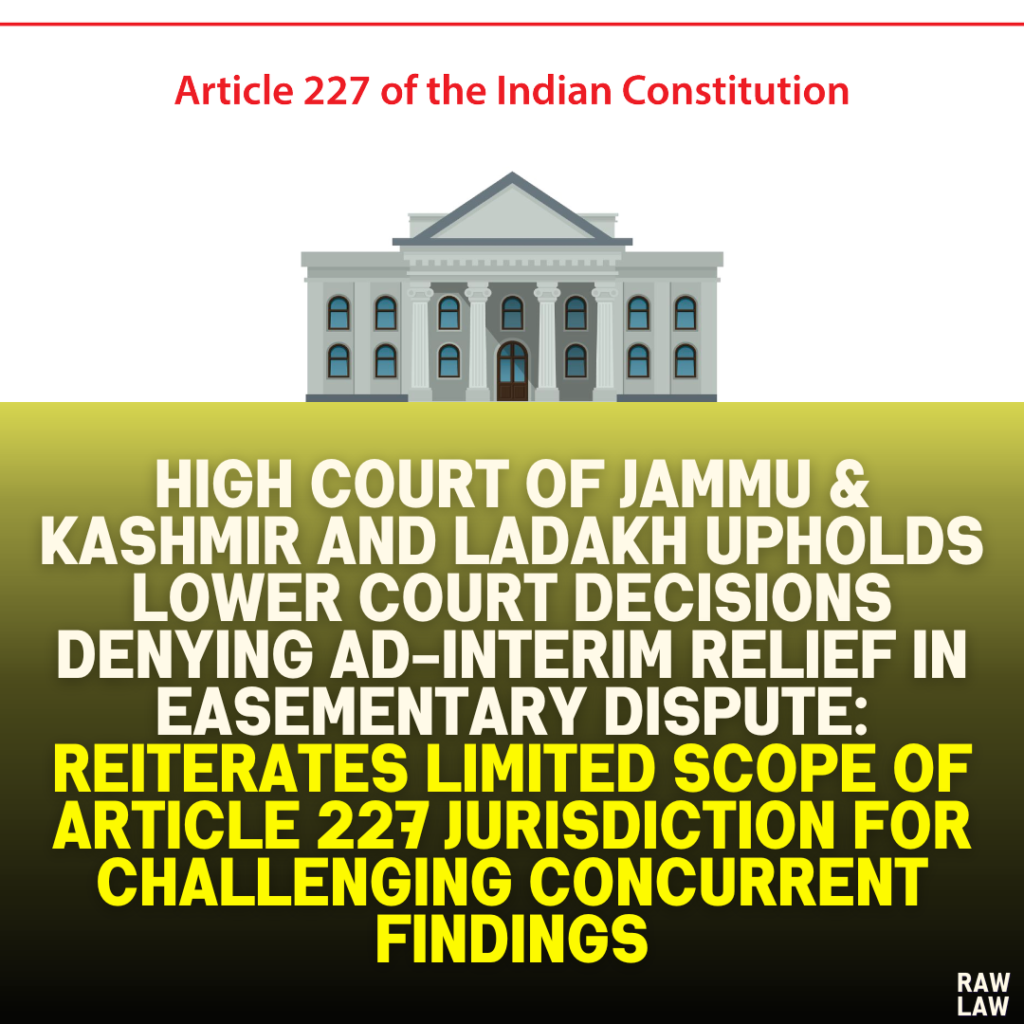Court’s Decision:
The High Court of Jammu & Kashmir and Ladakh dismissed the petition filed under Article 227 of the Constitution of India. The petitioner sought to overturn the orders of the Trial Court and the First Appellate Court, which denied him interim relief in an easementary dispute. The High Court ruled that it cannot interfere with the findings of the lower courts unless there is a significant jurisdictional error or manifest injustice. As both lower courts acted within their jurisdiction and correctly evaluated the factual circumstances, the High Court declined to grant relief. A related contempt petition was also dismissed as a consequence.
Facts of the Case:
- Property and Pathway Dispute:
The petitioner claimed ownership of a 13-marla piece of land in Pulwama, consisting of 3 marlas under Survey No. 1668 and 10 marlas under Survey No. 1669. He asserted that he was gifted the land by its previous owner along with a 2-marla pathway for ingress and egress. - Allegation Against Respondents:
The petitioner alleged that the respondents began construction on their adjoining land, blocking his access to the pathway. Despite his repeated requests and a pending application before the Tehsildar, the respondents continued the construction. - Legal Proceedings:
The petitioner filed a suit for permanent injunction in the Trial Court, seeking interim relief to stop the construction. The Trial Court dismissed his application for interim relief. The First Appellate Court upheld this decision, observing that the petitioner failed to provide evidence supporting his claim of easementary rights. - Challenge in High Court:
Aggrieved by the lower courts’ decisions, the petitioner approached the High Court under Article 227, seeking to overturn the orders and secure interim relief.
Issues:
- Whether the petitioner is entitled to interim relief in the context of the alleged obstruction of easementary rights.
- Whether the High Court, under its supervisory jurisdiction, can interfere with the concurrent findings of the Trial Court and the Appellate Court.
Petitioner’s Arguments:
- Entitlement to Pathway Access:
The petitioner argued that the pathway was essential for his ingress and egress and that blocking access caused him irreparable harm. - Misinterpretation of Documents:
He claimed the courts misinterpreted the gift agreement and the “Iqrar Nama” (agreement), which specifically mentioned his entitlement to the 2-marla pathway. - Impact of Orders:
The petitioner contended that denying interim relief undermined his easementary rights and allowed the respondents to continue construction, causing him irreversible damage.
Respondent’s Arguments:
- Factual Inadequacy:
The respondents argued that the petitioner failed to demonstrate his long-term use of the pathway or any entitlement under Section 15 of the Easementary Act, which requires proving continuous usage for 20 years. - Forum Shopping Allegation:
They accused the petitioner of suppressing material facts and forum shopping, highlighting his initial approach to the revenue authorities before filing the suit. - Judicial Reasoning of Lower Courts:
The respondents defended the lower courts’ findings, emphasizing that any construction on their part was already declared subject to the outcome of the suit. - Limited Scope of Article 227:
They maintained that the High Court should not interfere with concurrent findings based on factual evaluations.
Analysis of the Law:
The court referred to the principles laid down in Shalini Shyam Shetty v. Rajendra Shankar Patil (2010 (8) SCC 329). The Supreme Court ruled that:
- The High Court’s jurisdiction under Article 227 is supervisory, not appellate.
- It cannot re-evaluate evidence or substitute its opinion for that of lower courts, except in cases of jurisdictional error or manifest injustice.
- The power must be exercised sparingly and only when the findings of lower courts are perverse or wholly unjustified.
Applying these principles, the High Court found that both the Trial Court and the Appellate Court evaluated the pleadings and documents correctly and acted within their jurisdiction.
Precedent Analysis:
In addition to Shalini Shyam Shetty, the court relied on general principles of supervisory jurisdiction under Article 227, which prohibit interference with factual findings unless there is a gross miscarriage of justice. The court observed that both lower courts provided sufficient reasoning for their decisions, leaving no room for interference.
Court’s Reasoning:
- Evaluation of Evidence:
The Trial Court dismissed the interim relief application, noting that the petitioner failed to establish long-term use of the pathway or a valid easementary right. This was upheld by the Appellate Court. - Safeguarding Rights:
Both lower courts ensured the petitioner’s rights were protected by declaring that any construction by the respondents would be at their own risk and subject to removal if the petitioner succeeded in the suit. - High Court’s Limited Jurisdiction:
The High Court reiterated that its power under Article 227 does not extend to re-appreciating evidence or substituting its opinion for concurrent findings of lower courts unless there is a significant jurisdictional error.
Conclusion:
The High Court dismissed the petition, upholding the concurrent findings of the Trial Court and the Appellate Court. The petitioner’s claim for interim relief was rejected as he failed to demonstrate a valid entitlement to the pathway or any irreparable harm caused by the respondents’ construction. The related contempt petition was also dismissed as a consequence.
Implications:
This judgment reinforces the principle that High Courts must exercise their supervisory jurisdiction under Article 227 sparingly. It also emphasizes the importance of substantiating claims in easementary disputes with concrete evidence. For litigants, the ruling underscores the necessity of presenting a clear and complete case at the initial stages of litigation.




Pingback: Delhi High Court Cancels Trademark "RPG" for Bad Faith Adoption and Consumer Confusion: Reaffirms Protection of Well-Known Trademarks Against Dilution Across Dissimilar Goods - Raw Law
Pingback: Bombay High Court Removes Executrix for Mismanagement and Breach of Fiduciary Duty: "Executor Must Administer the Estate with Absolute Fidelity to the Will and Beneficiaries"; Appoints Court Receiver to Oversee Administration Following Allegatio